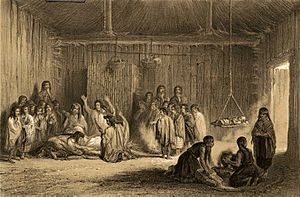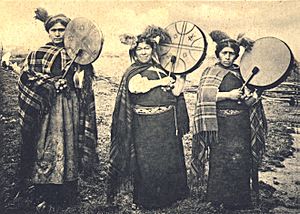Mapuche medicine facts for kids
Mapuche medicine is a traditional way of healing used by the Mapuche people in southern Chile. It combines beliefs about magic and religion, as people thought illnesses were caused by spirits or spells. To get better, they used special rituals, warm thermal waters, and healing herbs. Knowing about medicinal herbs is a very important part of Mapuche medicine, and people still use this knowledge today.
The Mapuche people also used surgery to treat injuries from battles. They knew how to fix broken bones and dislocated joints by wrapping them and using pastes made from healing plants.
Like in some parts of Europe, bloodletting was also a common treatment. This involved making small cuts with a sharp stone to let out blood. They believed this could help with many health problems. Sometimes, parents would even do this for their children, thinking it would make them lighter and stronger for work and fighting.
Staying clean was very important to the Mapuche. They bathed every day in rivers or streams, no matter the weather. They used the bark of the Quillaja tree as soap, which is still used in some products today!
Mapuche History and Healing
The Mapuche people came from a mix of two cultures: the Moluche people from what is now Argentina's Pampa region, and the native people living between the Toltén and Bío Bío rivers in Chile.
The Mapuche did not have a written language. They passed down all their knowledge, including their medical traditions, by telling stories and teaching each other. European explorers were the first to write down much of what we know about Mapuche culture and medicine.
Different Kinds of Healers
In Mapuche medicine, there were several types of healers, each with their own special skills.
- Vileus:
These healers believed that tiny insects or worms caused sickness. They often worked to cure widespread diseases that appeared after the Spanish arrived.
- Ampiver:
These were practical healers who learned by watching and trying things. They used simple remedies and techniques. They could even check blood pressure and make basic health guesses. Their main treatments involved using medicinal plants.
- Lawentuchefe:
These healers have a deep understanding of how to use herbs and plants for healing. They help people get better from different illnesses using this plant knowledge. Lawentuchefes are not like shamans; they don't have mystical powers. Their job is focused only on using plants to heal. Sadly, as native forests disappear, it's harder for Lawentuchefes to find the plants they need, which also means fewer of them are around in communities.
- Machi:
The machi was a very important healer, like a priest and a doctor combined. People usually went to a machi only if other healers couldn't help them. Machis knew some basic things about the human body. While they couldn't always figure out complex problems with many symptoms, they were good at treating simpler issues like skin rashes or joint pain. They also knew a lot about the healing power of hot springs and would tell patients which ones to visit. Machis could even perform small surgeries for fractures or minor growths. They were experts in medicinal plants, knowing exactly which part of a plant to use for the best healing effect.
If a patient wasn't getting better, the last step was a special spiritual ceremony called a "Machitún." Machis also gave advice and acted as guides for their communities.

During a Machitún ceremony, the machi would try to connect with the spirit world to find out what was wrong and how to cure it. For this, the machi would set up a special area in a small hut called a ruka. They would place laurel and canelo tree leaves in the center. A goat might be prepared for sacrifice as part of the ritual. Women would sing sad songs while the machi spread tobacco smoke. The machi would then enter a trance, playing the cultrún (a special drum), to communicate with spirits and find out how to help the patient.
Sometimes, the different types of healers would meet to solve a difficult health problem. This meeting was called a "Thauman."
Besides these main healers, there were also two other types of surgeons. The cupove was a pathologist who would examine bodies to understand diseases and causes of death. The gutave was a surgeon skilled at treating wounds, sores, and various injuries.
Mapuche Medicine Today
Today, there are special government programs that work to combine traditional Mapuche medicine with modern Western medicine. These programs aim to include the cultural ideas of Mapuche healing with new medical techniques. This helps bring modern healthcare into Mapuche communities in a way that respects their traditions. Examples include the "Programa de Salud Mapuche" (Mapuche Health Program) and the "Mesa Local (PROMAP)" (PROMAP Local Board). The PROMAP group specifically tries to include Mapuche ideas about health and the environment in its work.
See also
 In Spanish: Medicina mapuche para niños
In Spanish: Medicina mapuche para niños


